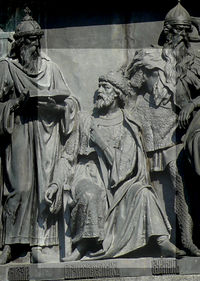Vladimir II Monomakh
- For the cruiser see Russian armoured cruiser Vladimir Monomakh, for the submarine see RFS Vladimir Monomakh
| Vladimir II Monomakh | |
|---|---|
| Grand Prince of Rus | |
 |
|
| Vladimir II Monomakh at the Millennium Monument in Novgorod | |
| Reign | 1113-1125 |
| Full name | Vladimir Vsevolodovich |
| Titles | Prince of Smolensk (1073-78) Prince of Chernigov (1078-94) Prince of Pereyaslav (1094-13) |
| Born | 1053 |
| Died | May 19, 1125 |
| Predecessor | Sviatopolk II |
| Successor | Mstislav I of Kiev |
| Dynasty | Rurik Dynasty |
| Father | Vsevolod I |
| Mother | Anastasia of Byzantium |
Vladimir II Monomakh (Russian: Владимир Мономах; Ukrainian: Володимир Мономах; Christian name Vasiliy, or Basileios) (1053 – May 19, 1125) was a famous Velikiy Kniaz (Grand Prince) of Kievan Rus'.
Contents |
Family
He was the son of Vsevolod I (married in 1046) and Anastasia of Byzantium (d. 1067). Her father which some give as Emperor Constantine IX Monomachos, is not attested in any reliable primary source.
Eupraxia of Kiev, a sister of Vladimir, became notorious all over Europe for her divorce from the Holy Roman Emperor Henry IV on the grounds that he had attempted a black mass on her naked body.
Reign

In his famous Instruction (also known as The Testament) to his own children, Monomakh mentions that he conducted 83 military campaigns and 19 times made peace with the Polovtsi. At first he waged war against the steppe jointly with his cousin Oleg, but after Vladimir was sent by his father to rule Chernigiv and Oleg made peace with the Polovtsi to retake that city from him, they parted company. Since that time, Vladimir and Oleg were bitter enemies who would often engage in internecine wars. The enmity continued among their children and more distant posterity.
From 1094, his chief patrimony was the southern town of Pereyaslav, although he also controlled Rostov, Suzdal, and other northern provinces. In these lands he founded several towns, notably his namesake, Vladimir, the future capital of Russia. In order to unite the princes of Rus' in their struggle against the Great Steppe, Vladimir initiated three princely congresses, the most important being held at Lyubech in 1097 and Dolobsk in 1103.
When Sviatopolk II died in 1113, the Kievan populace revolted and summoned Vladimir to the capital. The same year he entered Kiev to the great delight of the crowd and reigned there until his death in 1125. As may be seen from his Instruction, he promulgated a number of reforms in order to allay the social tensions in the capital. These years saw the last flowering of Ancient Rus, which was torn apart 10 years after his death.
Vladimir Monomakh is buried in the Saint Sophia Cathedral in Kiev. Succeeding generations often referred to his reign as the golden age of that city. Numerous legends are connected with Monomakh's name, including the transfer from Constantinople to Rus of such precious relics as the Theotokos of Vladimir and the Vladimir/Muscovite crown called Monomakh's Cap.
Marriages and children
Vladimir was married three times. His first wife was Gytha of Wessex, daughter of Harold of England who fell at Hastings and Edith Swannesha. They had at least five children:
- Mstislav I of Kiev (1 June 1076 - 14 April 1132).
- Izyaslav Vladimirovich, Prince of Kursk (c. 1077 - 6 September 1096).
- Svyatoslav Vladimirovich, Prince of Smolensk and Pereyaslav (c. 1080 - 16 March 1114).
- Yaropolk II of Kiev (1082 - 18 February 1139).
- Viacheslav I of Kiev (1083 - 2 February 1154).
The following daughter has been attributed to both the first and the second wife:
- Marina Vladimirovna (d. 1146). Married Leon Diogenes. A pretender to the throne of the Byzantine Empire, claiming to be a son of Romanos IV. Rose to the rank of khan of the Cumans in Ossetia.
The second wife is considered to have been a Byzantine noblewoman. The Primary Chronicle records her date of death on 7 May 1107. However the Chronicle does not mention her name. They had at least six children:

- Roman Vladimirovych, Prince of Volhynia (d. 6 January 1119).
- Eufemia of Kiev (d. 4 April 1139). Married Coloman of Hungary.
- Eupraxia of Kiev Vladimirovna (d. 1109).
- Agafia Vladimirovna. Married Vsevolod Davidovich, Prince of Gorodno. Her husband was a son of Davyd Igorevych, Prince of Volhynia (d. 1113).
- Yuri Dolgoruki (d. 15 May 1157).
- Andryi Vladimirovych, Prince of Volhynia (11 July 1102 - 1141).
His third marriage is thought to have been to a daughter of Aepa Ocenevich, Khan of the Cumans. Her paternal grandfather was Osen. Her people belonged to the Kipchaks, a confederation of pastoralists and warriors of Turkic origin.
However the Primary Chronicle identifies Aepa as father-in-law to Yuri Dolgoruki. With Vladimir negotiating the marriage in name of his son. Whether father and son married sisters or the identity of intended groom was misadentified is unclear.
See also
- List of Ukrainian rulers
- List of Russian rulers
- Council of Liubech
External links
- English biography
- Karamzin's account of Monomakh
- Instruction of Vladimir Monomakh
- The Pouchenie of Vladimir Monomakh
- The Pouchenie of Vladimir Monomakh (Russian)
- His listing in "Medieval lands" by Charles Cawley.
| Regnal titles | ||
|---|---|---|
| Preceded by Sviatopolk II |
Rulers of Kievan Rus | Succeeded by Mstislav |